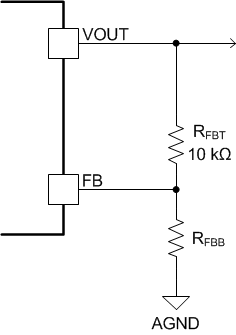SLVSE26B November 2017 – April 2018 TPSM84824
PRODUCTION DATA.
- 1 Features
- 2 Applications
- 3 Description
- 4 Revision History
- 5 Pin Configuration and Functions
- 6 Specifications
-
7 Detailed Description
- 7.1 Overview
- 7.2 Functional Block Diagram
- 7.3
Feature Description
- 7.3.1 Adjusting the Output Voltage
- 7.3.2 Switching Frequency (RT)
- 7.3.3 Synchronization (CLK)
- 7.3.4 Output On/Off Enable (EN)
- 7.3.5 Input Capacitor Selection
- 7.3.6 Output Capacitor Selection
- 7.3.7 TurboTrans (TT)
- 7.3.8 Undervoltage Lockout (UVLO)
- 7.3.9 Soft Start (SS/TR)
- 7.3.10 Sequencing (SS/TR)
- 7.3.11 Power Good (PGOOD)
- 7.3.12 Safe Start-up into Pre-Biased Outputs
- 7.3.13 Overcurrent Protection
- 7.3.14 Thermal Shutdown
- 7.4 Device Functional Modes
- 8 Application and Implementation
- 9 Power Supply Recommendations
- 10Layout
- 11Device and Documentation Support
- 12Mechanical, Packaging, and Orderable Information
Package Options
Mechanical Data (Package|Pins)
- MOL|24
Thermal pad, mechanical data (Package|Pins)
Orderable Information
7.3.1 Adjusting the Output Voltage
A resistor divider connected to the FB pin (pin 2) programs the output voltage of the TPSM84824. The output voltage adjustment range is from 0.6 V to 10 V. Figure 12 shows the feedback resistor connection for setting the output voltage. The recommended value of RFBT is 10 kΩ. The value for RFBB can be calculated using Equation 1 or simply selected from the range of values given in Table 1. Table 1 also includes the recommended switching frequency and minimum required output capacitance for each output voltage.
Equation 1. 

 Figure 12. Setting the Output Voltage
Figure 12. Setting the Output Voltage Table 1. Standard Component Values
| VOUT (V) | RFBB (kΩ) | RECOMMENDED
fSW (kHz) |
RRT (kΩ) | Minimum Required COUT(µF)(1)(2) | |
|---|---|---|---|---|---|
| CERAMIC | POLYMER(3) | ||||
| 0.6 | open | 250 | 200 | 400 | 220 |
| 0.7 | 60.4 | 250 | 200 | 400 | 220 |
| 0.8 | 30.1 | 300 | 165 | 300 | 220 |
| 0.9 | 20.0 | 350 | 143 | 200 | 220 |
| 1.0 | 15.0 | 400 | 124 | 200 | - |
| 1.1 | 12.1 | 400 | 124 | 200 | - |
| 1.2 | 10.0 | 450 | 110 | 200 | - |
| 1.3 | 8.66 | 500 | 97.6 | 200 | - |
| 1.4 | 7.50 | 500 | 97.6 | 200 | - |
| 1.5 | 6.65 | 550 | 88.7 | 150 | - |
| 1.6 | 6.04 | 550 | 88.7 | 150 | - |
| 1.7 | 5.49 | 600 | 82.5 | 150 | - |
| 1.8 | 4.99 | 600 | 82.5 | 100 | - |
| 1.9 | 4.64 | 650 | 75.0 | 100 | - |
| 2.0 | 4.32 | 700 | 69.8 | 100 | - |
| 2.5 | 3.16 | 800 | 60.4 | 100 | - |
| 3.3 | 2.21 | 1000 | 48.7 | 47 | - |
| 5.0 | 1.37 | 1200 | 40.2 | 47 | - |
| 6.0 | 1.10 | 1200 | 40.2 | 47 | - |
| 7.5 | 0.866 | 1300 | 36.5 | 47 | - |
| 9.0 | 0.715 | 1300 | 36.5 | 22 | - |
| 10 | 0.634 | 1300 | 36.5 | 22 | - |
(1) Additional capacitance above the minimum can be ceramic or polymer type.
(2) Load transients with > 2 A/µs slew rates or load steps exceeding 4 A may require additional capacitance, see TurboTrans.
(3) See Low-ESR Output Capacitors for details on polymer capacitors.